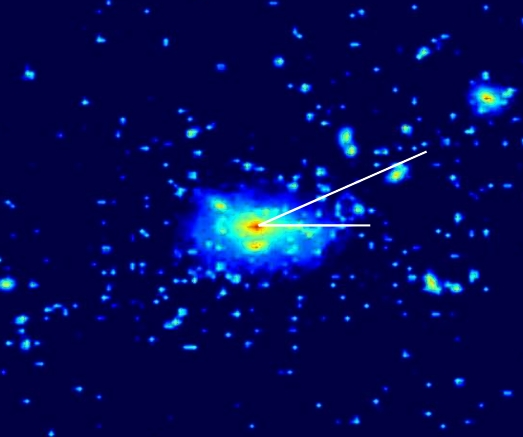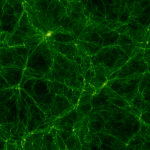
Cinthia Ragone-Figueroa, a researcher at the Instituto de Astronomía Teórica y Experimental (IATE), together with an international team, developed computational simulations that made it possible to verify that the galaxy clusters and their central galaxy have remained aligned for more than 8 thousand million years.
By Facundo Rodriguez
facundo.rodriguez@unc.edu.ar
In the Universe, there are a wide variety of galaxies. In order to study them, they are classified according to different criteria such as their shape, colour, brightness, whether they have an active nucleus, among others. Furthermore, it has been established that these properties are closely linked to the environments they inhabit.
The brightest
There is a very particular type which are the so-called "brightest cluster galaxies" (BCG). These, as the name implies, are found in groups of several dozens or hundreds of galaxies and are the brightest of each of these clusters. They have about ten times more mass than typical galaxies; in general, their shape is elliptical, and they are located in the centre of the clusters. Its size is explained by the privileged position they occupy, which allows them to take material from the rest of the cluster.

In the centre of this Hubble image the brightest and most massive galaxy can be seen in the Abell 2261 galaxy cluster.
Credits: NASA; ESA; M. Cartero, STScI; T. Lauer, NOAO, Tucson; Team CLASH.
BCG alignment
Some observational studies had indicated an alignment between the BCG and the cluster. One, in particular, found this alignment to a high redshift, that is, far away and in less evolved clusters. “From that publication, the idea arose to investigate if the alignment already existed in earlier stages of the Universe and how it has evolved. It was easy for us to do so by using simulations in which we can track galaxy clusters over time. Furthermore, we invited the authors of this publication to participate in this analysis, to be able to contrast together the results of our simulations with those obtained by them”, says Ragone-Figueroa, who is the main author of this work, which also includes researchers from Italy, Finland and the United States.
“As observed by observational clues, we found that structures that are at different scales, such as the BCG and the cluster, are not randomly located and oriented, but have shown an organization for at least 9 thousand million years”, explains Diego García Lambas, one of the members of the team that carried out this investigation and director of the IATE.

In this image, you can see one of the simulated clusters; and, in the centre, the BCG. The shortest line indicates the elongation of the brightest galaxy, while the longest corresponds to that of the cluster.
“This work also explores the persistence of alignment and shows that, although mergers with other groups of galaxies that can alter the alignment occur, the alignment is restored; this is one of the main results of the work”, expresses Ragone-Figueroa, who has carried out various studies related to the large-scale structure of the universe, BCGs and galaxy clusters.
Simulations
To reach the conclusions published in Monthly Notices of the Royal Astronomical Society journal, the researchers simulated 29 high-mass galaxy clusters. These simulations were mainly carried out by the Trieste Numerical Astrophysics Group, of which Ragone-Figueroa is part, and resources from the High-Performance Computer Center of Universidad Nacional de Córdoba (CCAD-UNC) were also used.
"One of the advantages of our simulations is that the masses and the evolution of the BCG correspond with observations, something that other teams have not been able to achieve with similar investigations", points out Gian Luigi Granato, one of the authors of the article and researcher at the National Institute of Astrophysics of Italy (INAF) and the Trieste Observatory.
The joint work between the IATE and the Observatory of Trieste was facilitated by theLatin American Chinese European Galaxy Formation Networkthat enabled the exchange of researchers between both institutions.
Further results
The work also served to emulate observations, which provide less information than the one available in simulations. This yielded promising results indicating that, although some of the information is lost or all the galaxies in the cluster are not seen, the alignments studied are detectable and persistent.
On the other hand, in general, these structures are supposed to have a spherical shape. Therefore, it is of great importance that these results show that the galaxy and the cluster are more oval than spherical and that their axes are aligned. These results could allow other groups to improve the mass determination of these structures.
Scientific publication |
| Evolution and Role of Mergers in the BCG-Cluster Alignment. A View from Cosmological Hydro-Simulations
Authors | C. Ragone-Figueroa, G. L. Granato, S. Borgani, R. De Propris, D. García Lambas, G. Murante, E. Rasia y M. West |
Alignments of large structures in the Universe |
| Large structures grow as much by the expansion of the Universe as by the gravitational attraction and fusion of bodies with each other, but it is not easy to determine what characteristics of these structures are related to each of these effects.
The alignments between galaxies, clusters, filaments, among others, are intensively studied because they can give us clues about the formation and evolution of structures. If the structures are aligned, they have likely had a joint origin or growth that must be explained. IATE researchers have extensive experience in studies exploring the alignment of large structures, ranging from doctoral theses and several articles to joint publications with scientists from various institutes around the world, including James Peebles, winner of the Nobel Prize in Physics 2019. |








